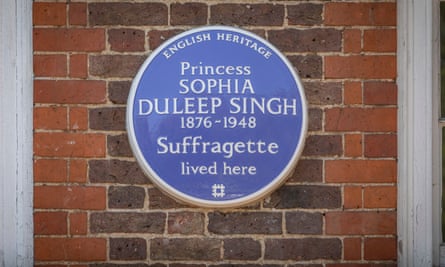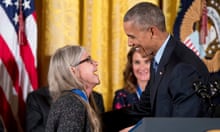The disparity between men and women honoured by the London blue plaques scheme is so great that it would take 300 years, at current rates, to reach equality between the sexes, English Heritage has said, as it called for people to continue nominating more women.
Despite significant progress having been made in recent years in recognising more notable women from history, Anna Eavis, the charity’s curatorial director, said the scheme would welcome many more diverse nominations, to fully recognise the capital’s “extraordinarily rich history”.
She was speaking before the unveiling on Friday of a plaque to commemorate Sophia Duleep Singh, an exiled Indian princess and goddaughter of Queen Victoria who became an outspoken suffragette, enraging the royal family. It was mounted on a building at Hampton Court palace, where Singh was granted a grace and favour apartment by Victoria, and where she would defiantly sell suffragette newsletters.

Singh was the daughter of the last Punjabi maharajah, Duleep Singh, who had been forced as a child to sign away the Koh-i-Noor diamond. While she had a fascinating biography in her own right, Eavis said her story also illustrated “the enormous social, economic, cultural revolution that has changed women’s lives over the last 130 years or so”.
The disparity between the numbers of women’s and men’s plaques starkly illustrates the historical exclusion of women: of more than 990 plaques currently in place in London, about 85% commemorate men. Even if only women were to be honoured from now on (a prospect that English Heritage stresses would never happen), it would take 50 years to reach numerical parity.
Eavis said some imbalance was inevitable given the place of women in history, and that achieving equal numbers in total was not their aim.
The priority, she said, was not “rummaging around in the 18th and 19th century [looking for women], though there are definitely figures who are there”. Instead, she said, “I’m more interested in ensuring that as time rolls on, we are capturing female figures who are undoubtedly making a contribution in more recent history.”
All applications, male and female, were considered equally, the charity has stressed. Notable people need to have been dead for only 20 years before they are nominated for the scheme, which began in 1866 and is thought to be the oldest project of its kind in the world.
The women’s rights activist and academic Helen Pankhurst, the great-granddaughter of the suffragette leader Emmeline Pankhurst, said that the privilege of Singh’s connections was balanced by the fact that she had been dispossessed, and by the fact that on her mother’s side she was descended from a German merchant banker and a formerly enslaved Ethiopian woman.

“She’s very interesting because of the relevance today of that complicated, rich personal identity. I think her story resonates today in very interesting ways. But fundamentally she uses both that privilege and those vulnerabilities to try to make a difference.”
An Indian princess with her connections had been “PR gold dust” to the suffragettes, Pankhurst said, and at key moments she had taken a prominent role in their campaign. So why is she not better known? “I wonder whether there were just so many characters. To be honest, history doesn’t know how to deal with the suffragette movement; because there are so many of them, it’s easier just to tell the story of one leader.”
She echoed calls for more diverse nominations to the blue plaques scheme. “It’s so frustrating that there are so many really interesting people in history that we are not showing the next generation. And we need to do that, because that is part of valuing the past, as [a way to] start to change the future.”
Other campaigners for women’s rights commemorated with blue plaques in London include Emmeline Pankhurst and her daughters Christabel and Sylvia, Dame Millicent Garrett Fawcett and Caroline Norton. English Heritage also recently marked the former headquarters of the National Union of Women’s Suffrage Societies (NUWSS).








